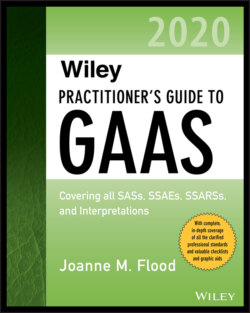Читать книгу Wiley Practitioner's Guide to GAAS 2020 - Joanne M. Flood - Страница 222
Step 2. Identification of Significant Risks
ОглавлениеAs part of assessing the risks of material misstatement, the auditor should identify significant risks, which are defined as those risks that require special audit consideration. Significant risks should be determined without regard to internal controls—that is, by considering inherent risk only. (AU-C 315.28) For example, if the entity is named as a defendant in a patent infringement lawsuit that may threaten the viability of its principal product, the auditor could consider significant the risks that the lawsuit (1) would not be appropriately recorded or disclosed in accordance with GAAP or (2) may affect the entity’s ability to continue as a going concern.
Significant risks arise on most audits. When the auditor determines that a risk is a significant risk, the audit procedures should include (but not be limited to):
Obtaining an understanding of internal control, including relevant control activities, related specifically to those significant risks
Evaluating whether the controls have been designed and implemented to mitigate the risks
(AU-C 315.30)
Substantive procedures specifically designed to address the significant risk. Significant risks frequently arise from unusual, nonroutine transactions and from judgmental matters such as estimates. (AU-C 315.31) In addition, significant risks may relate to matters such as the following:
External circumstances. External circumstances giving rise to business risks influence the determination of whether the risk requires special audit attention. For example, technological developments might make a particular product obsolete, thereby causing inventory to be more susceptible to overstatement. Recent significant economic, accounting, or other developments also may require special attention.
Factors in the client and its environment. Factors in the client and its environment that relate to several or all of the classes of transactions, account balances, or disclosures may influence the relative significance of the risk. For example, a lack of sufficient working capital to continue operations or a declining industry characterized by a large number of business failures may have a pervasive effect on risk for several account balances, classes of transactions, or disclosures.
Recent developments. Recent significant economic, accounting, or other developments can affect the relative significance of a risk.
Complex calculations. Complex calculations are more likely to be misstated than are simple calculations.
Risk of fraud or theft. Revenue recognition is presumed to be a financial reporting fraud risk; cash is more susceptible to misappropriation than an inventory of coal.
Estimates. Accounts consisting of amounts derived from accounting estimates that are subject to significant measurement uncertainty pose greater risks than do accounts consisting of relatively routine, factual data.
Related-party transactions. Related-party transactions may create business risks that can result in a material misstatement of the financial statements.
